file:///E|/TEMP/Assembly%20LanguageChapt%200.htm
Assembly Language:
Step-by-Step
Jeff Duntemann
file:///E|/TEMP/Assembly%20LanguageChapt%200.htm (1 of 23) [9/30/02 08:15:26 PM]
�
file:///E|/TEMP/Assembly%20LanguageChapt%200.htm
John Wiley & Sons, Inc.
New York • Chichester • Brisbane • Toronto • Singapore
This publication is designed to provide accurate and authoritative information in regard to
the subject matter covered. It is sold with the understanding that the publisher is not
engaged in rendering legal, accounting, or other professional service. If legal advice or
other expert assistance is required, the services of a competent professional person should
be sought. FROM A DECLARATION OF PRINCIPLES JOINTLY ADOPTED BY A
COMMITTEE OF THE AMERICAN BAR ASSOCIATION AND A COMMITTEE OF
PUBLISHERS.
Copyright © 1992 by John Wiley & Sons, Inc.
All rights reserved. Published simultaneously in Canada
Reproduction or translation of any part of this work beyond that permitted by section 107
or 108 of the 1976 United States Copyright Act without the written permission of the
copyright owner is unlawful. Requests for permission or further information should be
addressed to the Permissions Department, John Wiley & Sons, Inc.
file:///E|/TEMP/Assembly%20LanguageChapt%200.htm (2 of 23) [9/30/02 08:15:27 PM]
�
file:///E|/TEMP/Assembly%20LanguageChapt%200.htm
For Kathleen M. Duntemann, Godmother
... who gave me books when all I could do was put teeth marks in
It was a good investment.
Recognizing the
importance of
preserving what
has been written, it
is a policy of John
Wiley & Sons,
Inc. to have books
of enduring value
published in the
United States
printed on acid-
free paper, and we
exert our best
efforts to that end.
Library of Congress Cataloging-in-Publication Data
Duntemann, Jeff. 1952 -
Assembly language : step-by-step / Jeff Duntemann.
p. cm. Includes index.
ISBN 0-471-57814-2 (paper : alk. paper) 1. Assembler language (Computer program
file:///E|/TEMP/Assembly%20LanguageChapt%200.htm (3 of 23) [9/30/02 08:15:27 PM]
�
file:///E|/TEMP/Assembly%20LanguageChapt%200.htm
language) QA76.73.A8D87 1992 005.265-dc20
I. Title.
92-16665 CIP
Printed in the United States of America
93 10 9876543
Introduction:
Agony in the Key of AX
What astonishes me about learning how to program is not that it's so hard, but that it's so
easy. Am I nuts? Hardly. It's just that my curse is the curse of a perfect memory, and I
remember piano lessons. My poor mother paid $600 in 1962 for a beautiful cherrywood
spinet, and every week for two years I trucked off to Wilkins School of Music for a five
dollar lesson. It wasn't that I was a reluctant student; I love music and I genuinely wanted
to master the damned thing. But after two years, the best I could do was play "Camelot"
well enough to keep the dog from howling. I can honestly say that nothing I ever tried
file:///E|/TEMP/Assembly%20LanguageChapt%200.htm (4 of 23) [9/30/02 08:15:27 PM]
�
file:///E|/TEMP/Assembly%20LanguageChapt%200.htm
and failed to achieve after that (including engineering school and sailboarding) was
anything close to that difficult.
That's why I say: if you can play the piano, you can learn to program in assembly
language. Even if you can't play the piano, I hold that you can learn to program in
assembly language, if:
• You've ever done your own long-form taxes
• You've earned a degree in medicine, law, or engineering
• You've ever put together your kid's swing set
• You've ever cooked a five-course dinner for eight and gotten everything to the table,
hot, at all the right times
Still, playing the piano is the acid test. There are a lot more similarities than there are
differences. To wit:
In both cases, you sit down in front of a big expensive machine with a keyboard. You try
to memorize a system of notation that seems to have originated on Mars. You press the
keys according to incomprehensible instructions in stacks of books. Ultimately, you sit
there and grit your teeth while making so many mistakes your self-confidence dribbles
out of your pores and disappears into the carpet padding. In many cases, it gets so bad
that you hurl the books against the wall and stomp off to play Yahtzee with your little
brother.
The differences are fewer: mistakes committed while learning assembly language won't
make the dog howl. And, more crucially, what takes years of agony in front of a piano
can be done in a couple of months in front of your average PC.
Furthermore, I'll do my best to help.
That's what this book is for: to get you started as an assembly-language programmer from
a dead stop. I'll assume that you know how to run your machine. That is, I won't go
through all that nonsense about flipping the big red switch and inserting a disk in a drive
and holding down the Ctrl key while pressing the C key. Van Wolverton can teach you all
that stuff.
On the other hand, I won't assume that you know anything about programming, nor very
much about what happens inside the box itself. That means the first few sections will be
the kind of necessary groundwork that will start you nodding off if you've been through it
already. There's no helping that. Skip to Section 3 or so if you get bored.
I also have to come clean here and admit that this book is not intended to be a complete
tutorial on assembly language, or even close to it. What I want to do is get you familiar
enough with the jargon and the assumptions of assembly language so that you can pick up
your typical "introduction" to assembly language and not get lost by page 6. I specifically
recommend Tom Swan's excellent book, Mastering Turbo Assembler, which will take
file:///E|/TEMP/Assembly%20LanguageChapt%200.htm (5 of 23) [9/30/02 08:15:27 PM]
�
file:///E|/TEMP/Assembly%20LanguageChapt%200.htm
you the rest of the way if you use Borland's assembler. A comparable book devoted to
Microsoft's MASM has not yet been written, but even if you use MASM, Tom's book will
still be valuable and you'll learn a lot from it. Mastering Turbo Assembler can
occasionally be found in bookstores, or you can order it by mail through PC
TECHNIQUES Bookstream.
Assembly language is almost certainly the most difficult kind of computer programming,
but keep in mind that we're speaking in relative terms here. Five pushups are harder to do
than five jumping jacks—but compared to running the Marathon, both amount to almost
nothing. Assembly language is more difficult to learn than Pascal, but compared to
raising your average American child from birth to five years, it's a cakewalk.
So don't let the mystique get you. Assembly-language programmers feel pretty smug
about what they've learned to do, but in our workaday lives we are forced to learn and do
things that put even assembly language to shame. If you're willing to set aside a couple
months' worth of loose moments, you can pick it up too. Give it a shot. Your neighbors
will thank you.
And so will the dog.
—-Jeff Duntemann Scottsdale, AZ March 1992
A Note to People Who
Have Never Programmed
Before
More than anyone else, this book was written for you. Starting with assembly language
would not be most people's first choice in a computer language, but it's been done; it can
be done, and it can be done with less agony than you might think. Still, it's a novel aim
for a computer book, and I'd like you to do a little quality control for me and tell me how
I'm doing.
While you're going through this book, ask yourself once in a while: is it working? And if
file:///E|/TEMP/Assembly%20LanguageChapt%200.htm (6 of 23) [9/30/02 08:15:27 PM]
�
file:///E|/TEMP/Assembly%20LanguageChapt%200.htm
not, why not?
If I lose you somewhere in the discussion, jot a note in the margin. Tell me where I lost
you. If possible, tell me why. (And saying, "I just don't get it" is perfectly acceptable, as
long as you tell me where in the book you were when you started not to get it.)
As with all my books, I hope to keep this one in print well into the 21st century, revising
it as need be to hone my technique and follow the technology. Telling me how the book
works or doesn't work will, in time, help me make a better book.
Write to me at:
Jeff Duntemann PC TECHNIQUES Magazine
7721 E. Gray Road #204
Scottsdale, A2 85260
I can't reply individually to all letters, (not if I ever intend to get another book written!)
but you'll have my eternal gratitude nonetheless.
How to Get the Most
from this Book
By design, this is a serial-access book. I wrote it to be read like one of those
bad/wonderful novels, starting at page one and moving right along to the end. Virtually
all of the chapters depend on the chapters that came before them, and if you read a
chapter here and a chapter there, there's some danger that the whole thing won't gel.
If you're already familiar with programming, you could conceivably skip Chapters 0,1,
and 2. But why not assume there's a hole or two in parts of your experience and a little
rust on the rest? Skill is not simply knowledge, but the resonance that comes of seeing
how different facets of knowledge reinforce one another.
Do it all. Get the big picture. (Keep in mind that I've hidden some funny stories in
there as bait!)
file:///E|/TEMP/Assembly%20LanguageChapt%200.htm (7 of 23) [9/30/02 08:15:27 PM]
�
file:///E|/TEMP/Assembly%20LanguageChapt%200.htm
Contents
Chapter 0 Another Pleasant Valley Saturday
Understanding What Computers Really Do
0.1 It's All in the Plan 2
0.2 Had This Been the Real Thing... 5
0.3 Do Not Pass GO 5
Chapter 1 Alien Bases 13
Getting Your Arms around Binary and Hexadecimal
1. 1 The Return of the New Math Monster 14
1.2 Counting in Martian 14
1.3 Octal: How the Grinch Stole 8 and 9 19
1.4 Hexadecimal: Solving the Digit Shortage 22
1.5 From Hex to Decimal and From Decimal to Hex 25
1.6 Arithmetic in Hex 29
1.7 Binary 34
1.8 Hexadecimal as Shorthand for Binary 38
Chapter 2 Lifting The Hood 41
Discovering What Computers Actually Are
2.1 RAXie, We Hardly Knew Ye... 42
2.2 Switches, Transistors, and Memory 43
2.3 The Shop Foreman and the Assembly Line 53
2.4 The Box that Follows a Plan 58
Chapter 3 The Right To Assemble 63
The Process of Making Assembly-Language Programs
3.1 Nude with Bruises and Other Perplexities 64
3.2 DOS and DOS Files 65
3.3 Compilers and Assemblers 71
3.4 The Assembly-Language Development Process 79
file:///E|/TEMP/Assembly%20LanguageChapt%200.htm (8 of 23) [9/30/02 08:15:27 PM]
�
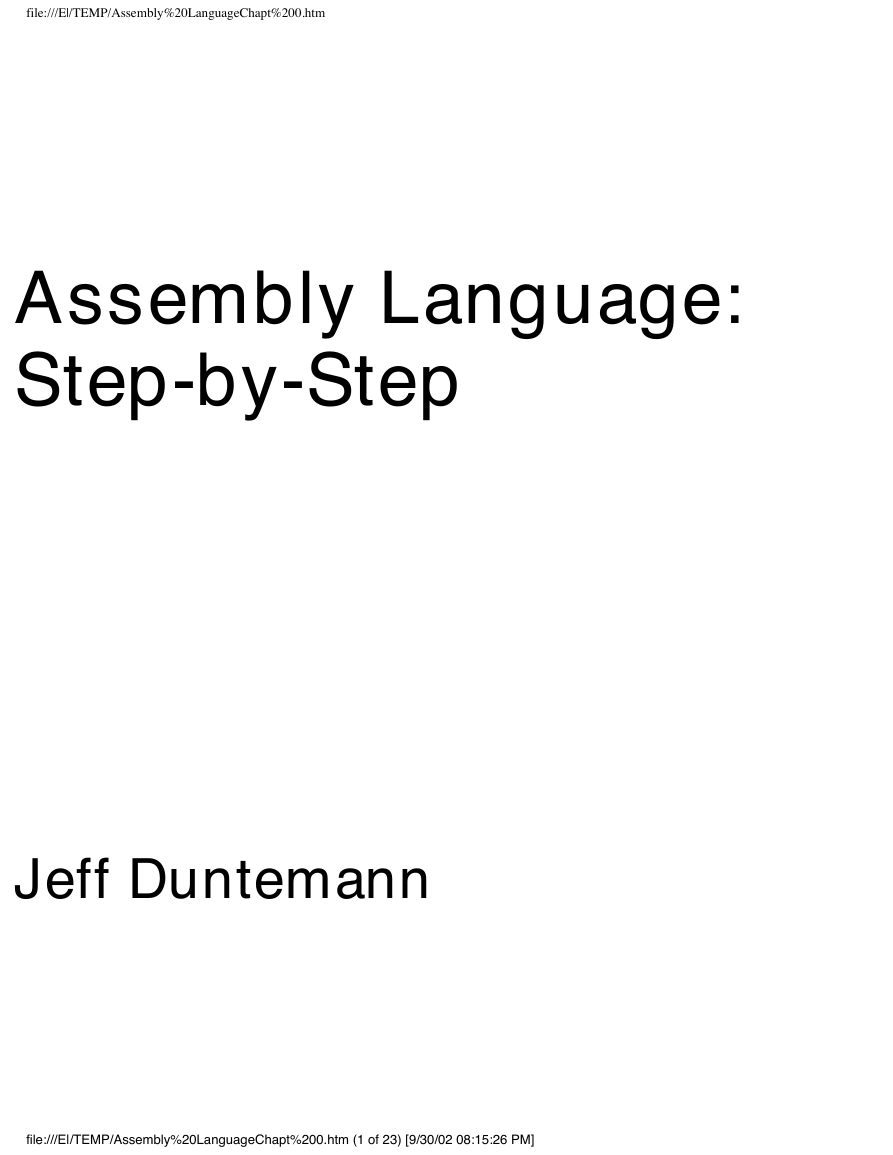

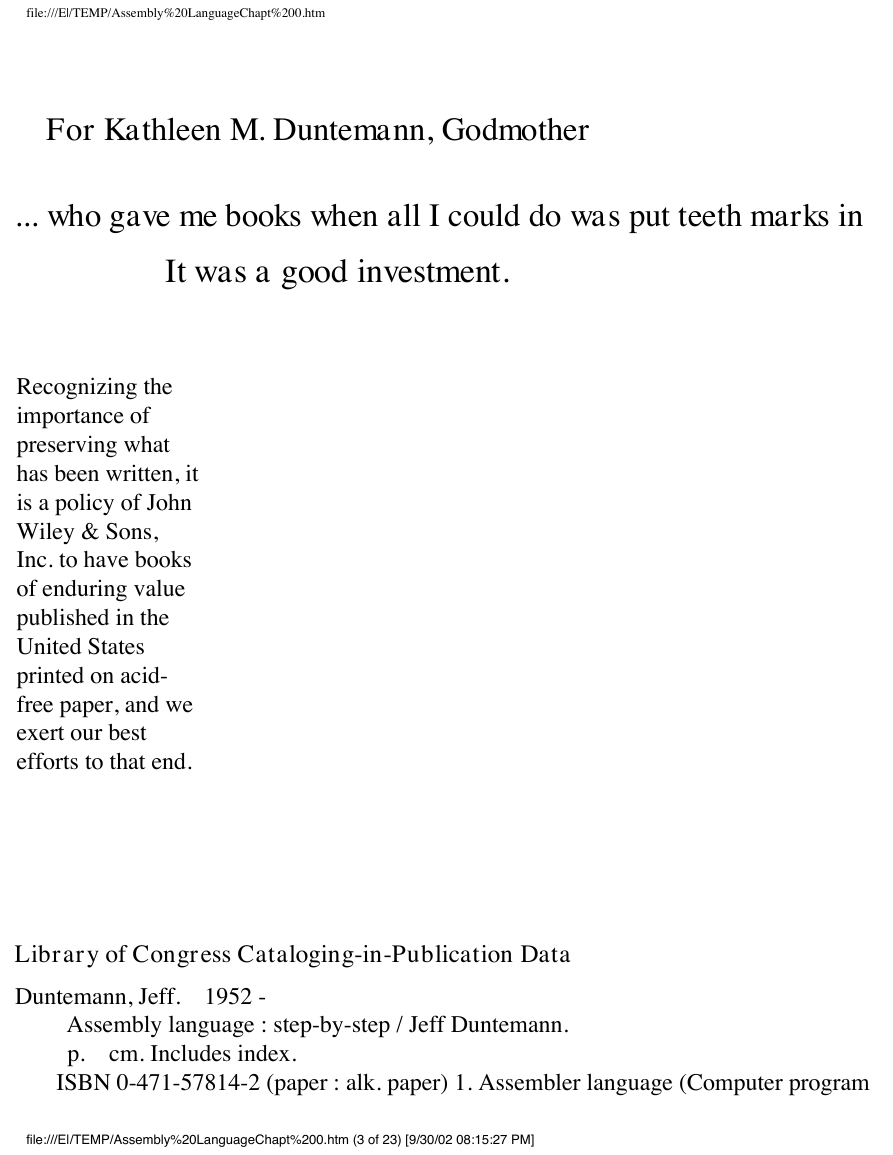
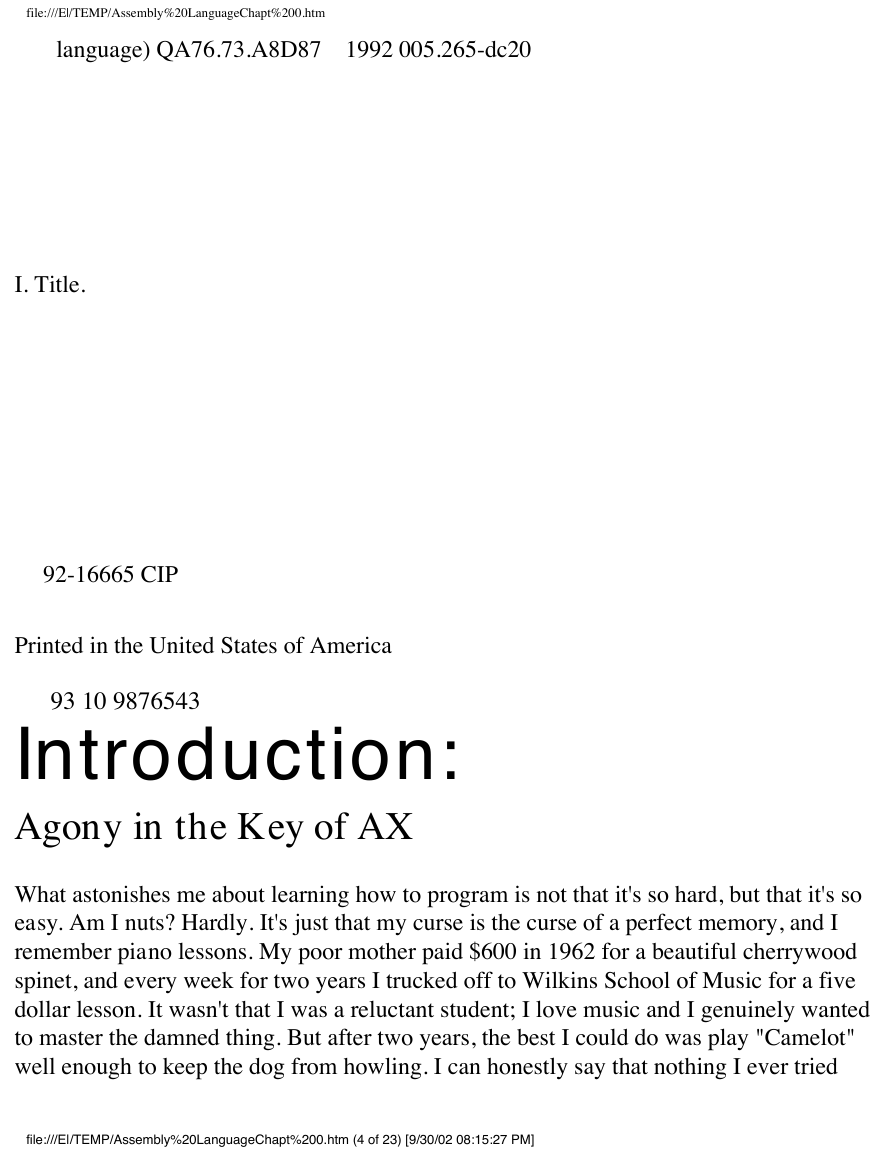
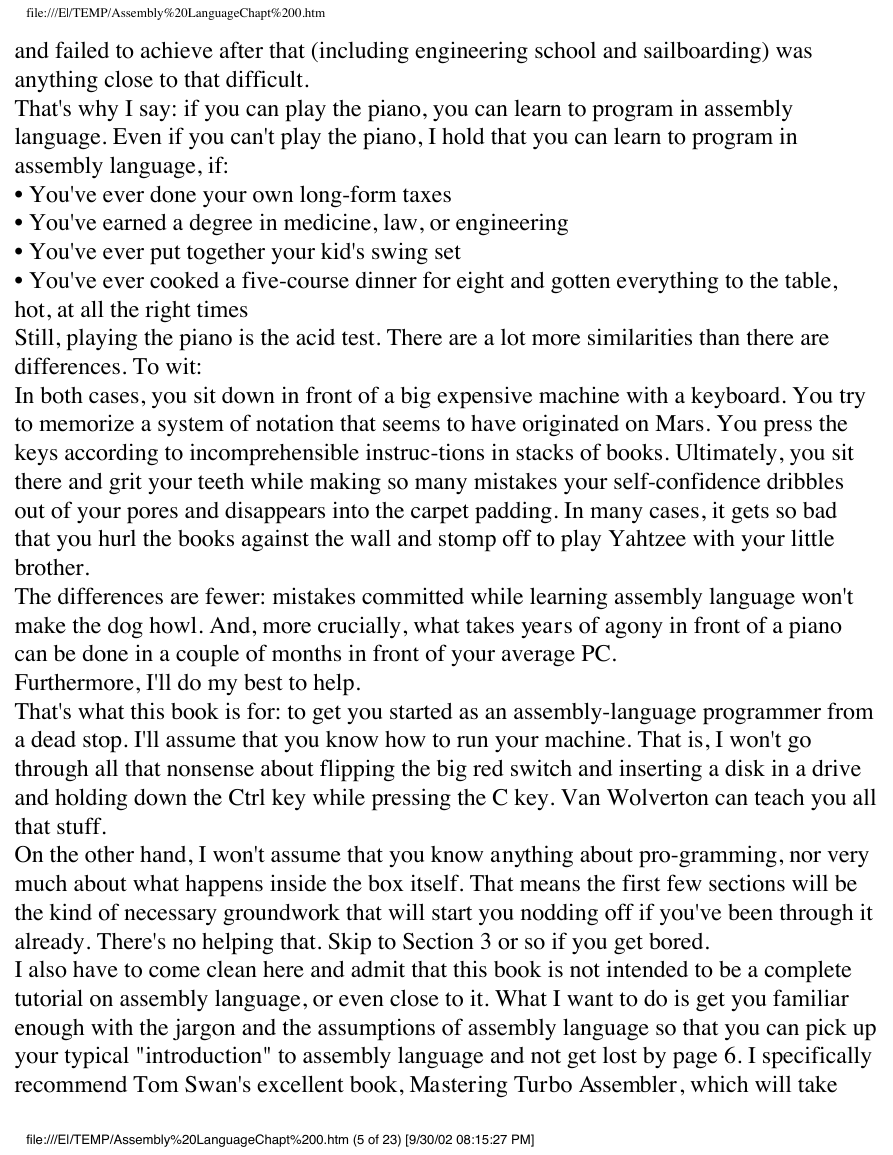
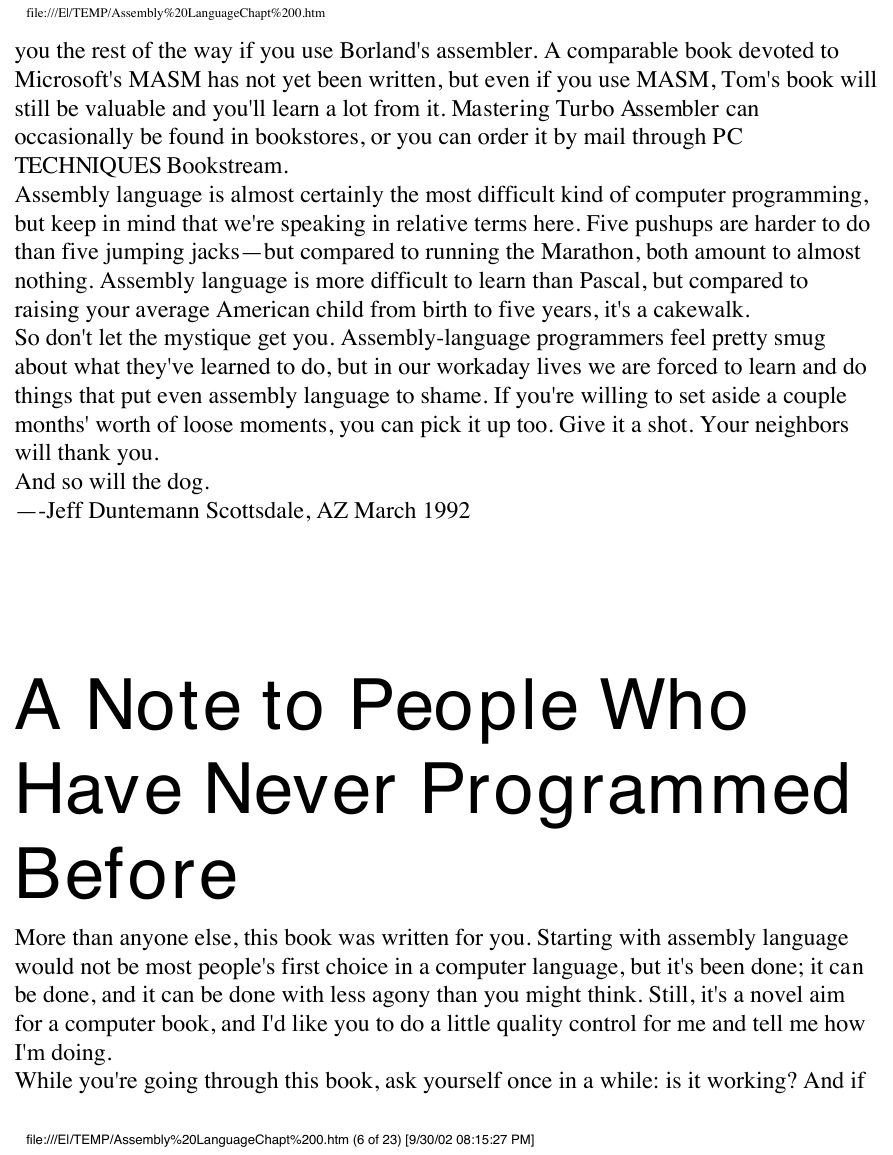
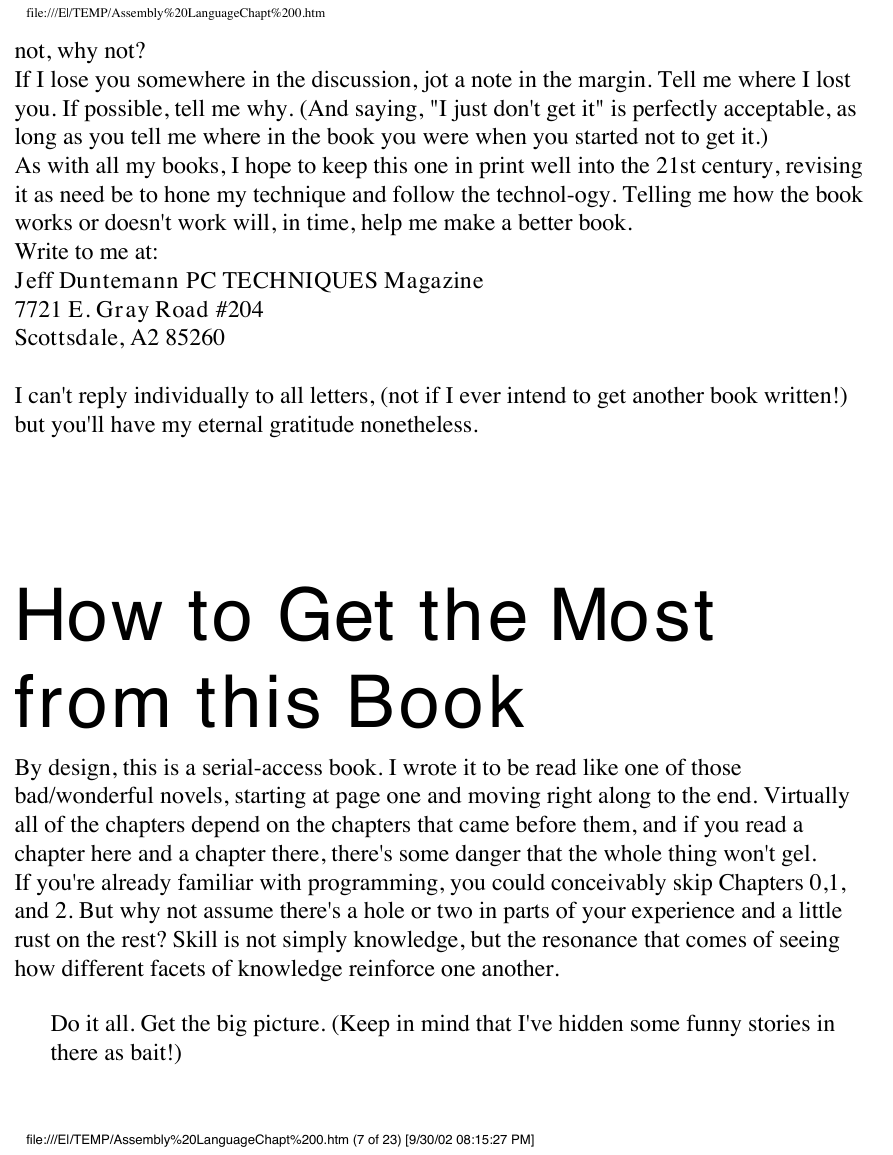
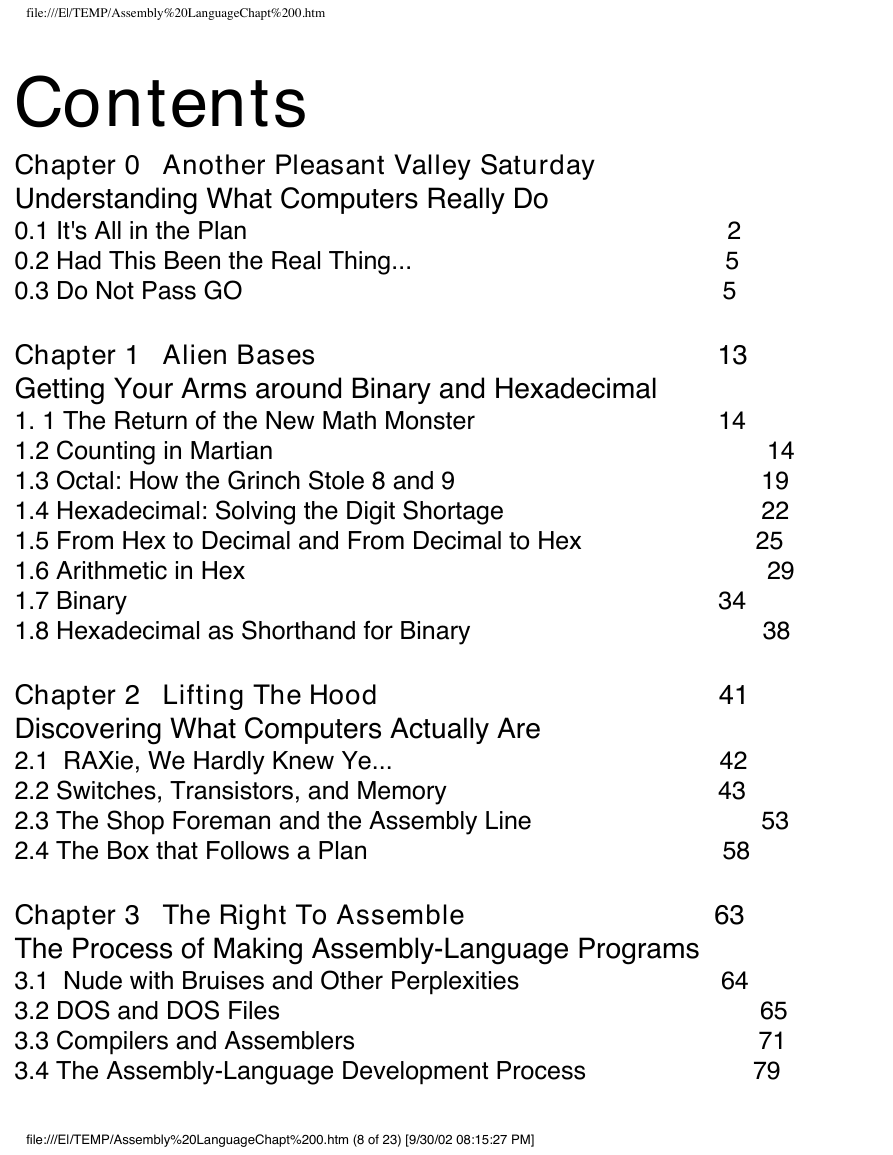








 2023年江西萍乡中考道德与法治真题及答案.doc
2023年江西萍乡中考道德与法治真题及答案.doc 2012年重庆南川中考生物真题及答案.doc
2012年重庆南川中考生物真题及答案.doc 2013年江西师范大学地理学综合及文艺理论基础考研真题.doc
2013年江西师范大学地理学综合及文艺理论基础考研真题.doc 2020年四川甘孜小升初语文真题及答案I卷.doc
2020年四川甘孜小升初语文真题及答案I卷.doc 2020年注册岩土工程师专业基础考试真题及答案.doc
2020年注册岩土工程师专业基础考试真题及答案.doc 2023-2024学年福建省厦门市九年级上学期数学月考试题及答案.doc
2023-2024学年福建省厦门市九年级上学期数学月考试题及答案.doc 2021-2022学年辽宁省沈阳市大东区九年级上学期语文期末试题及答案.doc
2021-2022学年辽宁省沈阳市大东区九年级上学期语文期末试题及答案.doc 2022-2023学年北京东城区初三第一学期物理期末试卷及答案.doc
2022-2023学年北京东城区初三第一学期物理期末试卷及答案.doc 2018上半年江西教师资格初中地理学科知识与教学能力真题及答案.doc
2018上半年江西教师资格初中地理学科知识与教学能力真题及答案.doc 2012年河北国家公务员申论考试真题及答案-省级.doc
2012年河北国家公务员申论考试真题及答案-省级.doc 2020-2021学年江苏省扬州市江都区邵樊片九年级上学期数学第一次质量检测试题及答案.doc
2020-2021学年江苏省扬州市江都区邵樊片九年级上学期数学第一次质量检测试题及答案.doc 2022下半年黑龙江教师资格证中学综合素质真题及答案.doc
2022下半年黑龙江教师资格证中学综合素质真题及答案.doc